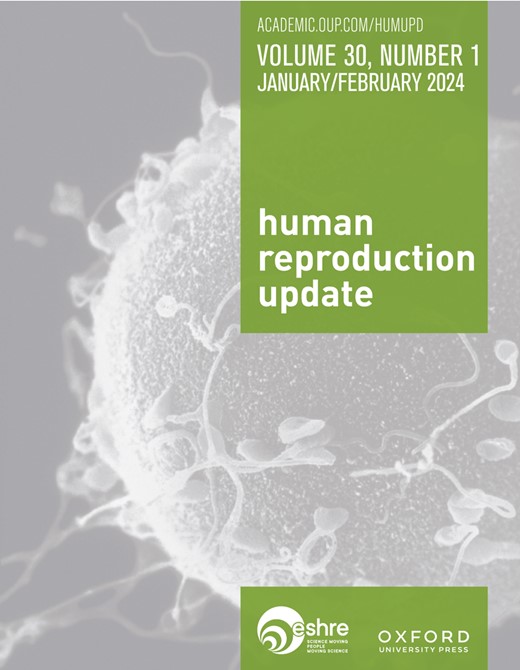子宫内膜疾病的生物技术进步和再生疗法的发展:系统综述
IF 16.1
1区 医学
Q1 OBSTETRICS & GYNECOLOGY
引用次数: 0
摘要
背景怀孕的建立和维持取决于子宫内膜的功能。阿瑟曼综合征(AS)和宫腔内粘连(IUA),或子宫内膜萎缩(EA)和子宫内膜薄(TE),既可能是自发性的,也可能是由于疾病(如子宫内膜炎或先天性发育不良)或医疗干预(如手术、激素疗法、子宫刮宫术或放疗)引起的。受影响的患者可能会出现子宫内膜改变或不足的情况,从而阻碍胚胎着床,增加不良妊娠结局和流产的风险。在人类中,AS/IUA 和 EA/TE 主要通过手术或药物治疗进行治疗,但这些治疗方法的疗效仍不明确。因此,利用干细胞、生长因子或组织工程的新型再生技术应运而生,以改善生殖结果。目标和理由 本综述全面总结了治疗人类子宫内膜病变的新兴生物技术(细胞、细胞和生物工程方法)的方法和结果。文中讨论了在临床前模型(体外和体内)和临床试验中研究的源自人体组织或血液的再生疗法。检索方法 对PubMed和Embase中的全文文章进行了系统检索,以确定2000年1月至2023年9月期间以英文发表的、经同行评审的原创研究。搜索关键词包括人类、子宫、子宫内膜、阿什曼综合征、宫腔内粘连、子宫内膜萎缩、子宫内膜薄、子宫内膜炎、先天性子宫发育不良、刮宫、放射治疗、再生治疗、生物工程、干细胞、囊泡、富血小板血浆、生物材料、微流体、生物打印、类器官、水凝胶、支架、薄片、miRNA、西地那非、硝酸甘油、阿司匹林、生长激素、孕酮和雌激素。有关修复或再生人类子宫内膜的细胞、细胞和生物工程策略的临床前和临床研究也包括在内。其他研究则通过人工搜索确定。结果 从总共 4366 条记录中,有 164 项研究(3.8%)被纳入系统综述。由于临床前和临床研究在研究设计和测量结果参数方面存在异质性,因此在未进行荟萃分析的情况下,对研究结果进行了定性和定量评估。以干细胞为基础治疗子宫内膜病变的研究小组通常采用从骨髓或脐带中提取的间充质干细胞(MSCs)。另外,基于富血小板血浆(PRP)或细胞外囊泡的细胞疗法也越来越受欢迎。与此同时,基于细胞外基质(ECM)衍生的水凝胶或合成生物仿制药的生物工程策略也在不断涌现,可维持细胞和生长因子的局部输送,并取得了可喜的成果。针对组织修复和再生多个方面的综合疗法仍处于临床前试验阶段,但已显示出转化价值。本综述重点介绍了已测试过的各种治疗材料来源、给药方法和载体。更广泛的意义 促进子宫内膜增殖、血管发育和组织修复的疗法可能有助于恢复子宫内膜功能,并最终恢复生育能力。基于现有的证据、成本、可及性和疗法的可用性,我们建议开发三重打击再生策略,可能将高产间充质干细胞(如来自骨髓或脐带的间充质干细胞)与细胞治疗(PRP)相结合,也可能与 ECM 水凝胶相结合。生物技术的进步与临床前模型的研究成果将为开发针对导致不孕的子宫内膜疾病(如 AS/IUA、EA/TE 和子宫内膜炎)患者的个性化治疗方案铺平道路。注册号 https://osf.io/th8yf/本文章由计算机程序翻译,如有差异,请以英文原文为准。
Evolution of biotechnological advances and regenerative therapies for endometrial disorders: a systematic review
BACKGROUND The establishment and maintenance of pregnancy depend on endometrial competence. Asherman syndrome (AS) and intrauterine adhesions (IUA), or endometrial atrophy (EA) and thin endometrium (TE), can either originate autonomously or arise as a result from conditions (i.e. endometritis or congenital hypoplasia), or medical interventions (e.g. surgeries, hormonal therapies, uterine curettage or radiotherapy). Affected patients may present an altered or inadequate endometrial lining that hinders embryo implantation and increases the risk of poor pregnancy outcomes and miscarriage. In humans, AS/IUA and EA/TE are mainly treated with surgeries or pharmacotherapy, however the reported efficacy of these therapeutic approaches remains unclear. Thus, novel regenerative techniques utilizing stem cells, growth factors, or tissue engineering have emerged to improve reproductive outcomes. OBJECTIVE AND RATIONALE This review comprehensively summarizes the methodologies and outcomes of emerging biotechnologies (cellular, acellular, and bioengineering approaches) to treat human endometrial pathologies. Regenerative therapies derived from human tissues or blood which were studied in preclinical models (in vitro and in vivo) and clinical trials are discussed. SEARCH METHODS A systematic search of full-text articles available in PubMed and Embase was conducted to identify original peer-reviewed studies published in English between January 2000 and September 2023. The search terms included: human, uterus, endometrium, Asherman syndrome, intrauterine adhesions, endometrial atrophy, thin endometrium, endometritis, congenital hypoplasia, curettage, radiotherapy, regenerative therapy, bioengineering, stem cells, vesicles, platelet-rich plasma, biomaterials, microfluidic, bioprinting, organoids, hydrogel, scaffold, sheet, miRNA, sildenafil, nitroglycerine, aspirin, growth hormone, progesterone, and estrogen. Preclinical and clinical studies on cellular, acellular, and bioengineering strategies to repair or regenerate the human endometrium were included. Additional studies were identified through manual searches. OUTCOMES From a total of 4366 records identified, 164 studies (3.8%) were included for systematic review. Due to heterogeneity in the study design and measured outcome parameters in both preclinical and clinical studies, the findings were evaluated qualitatively and quantitatively without meta-analysis. Groups using stem cell-based treatments for endometrial pathologies commonly employed mesenchymal stem cells (MSCs) derived from the human bone marrow or umbilical cord. Alternatively, acellular therapies based on platelet-rich plasma (PRP) or extracellular vesicles are gaining popularity. These are accompanied by the emergence of bioengineering strategies based on extracellular matrix (ECM)-derived hydrogels or synthetic biosimilars that sustain local delivery of cells and growth factors, reporting promising results. Combined therapies that target multiple aspects of tissue repair and regeneration remain in preclinical testing but have shown translational value. This review highlights the myriad of therapeutic material sources, administration methods, and carriers that have been tested. WIDER IMPLICATIONS Therapies that promote endometrial proliferation, vascular development, and tissue repair may help restore endometrial function and, ultimately, fertility. Based on the existing evidence, cost, accessibility, and availability of the therapies, we propose the development of triple-hit regenerative strategies, potentially combining high-yield MSCs (e.g. from bone marrow or umbilical cord) with acellular treatments (PRP), possibly integrated in ECM hydrogels. Advances in biotechnologies together with insights from preclinical models will pave the way for developing personalized treatment regimens for patients with infertility-causing endometrial disorders such as AS/IUA, EA/TE, and endometritis. REGISTRATION NUMBER https://osf.io/th8yf/
求助全文
通过发布文献求助,成功后即可免费获取论文全文。
去求助
来源期刊

Human Reproduction Update
医学-妇产科学
CiteScore
28.80
自引率
1.50%
发文量
38
期刊介绍:
Human Reproduction Update is the leading journal in its field, boasting a Journal Impact FactorTM of 13.3 and ranked first in Obstetrics & Gynecology and Reproductive Biology (Source: Journal Citation ReportsTM from Clarivate, 2023). It specializes in publishing comprehensive and systematic review articles covering various aspects of human reproductive physiology and medicine.
The journal prioritizes basic, transitional, and clinical topics related to reproduction, encompassing areas such as andrology, embryology, infertility, gynaecology, pregnancy, reproductive endocrinology, reproductive epidemiology, reproductive genetics, reproductive immunology, and reproductive oncology. Human Reproduction Update is published on behalf of the European Society of Human Reproduction and Embryology (ESHRE), maintaining the highest scientific and editorial standards.
 求助内容:
求助内容: 应助结果提醒方式:
应助结果提醒方式:


